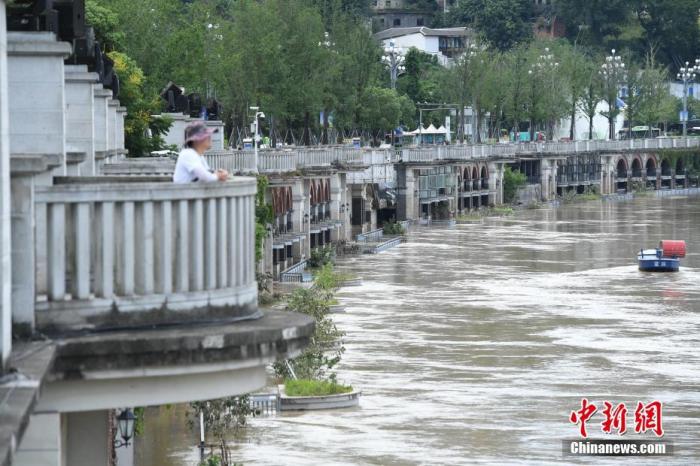China News Service, August 17th. According to the website of the Ministry of Water Resources, the No. 5 flood of 2020 occurred in the Yangtze River due to the continuous heavy rainfall in recent days. The Ministry of Water Resources has studied and refined the dispatching plans and flood response measures for the Three Gorges and other reservoirs. At the same time, it has made every effort to deal with storms and floods in Sichuan and Chongqing.
Data map: The water level of the Yangtze River rises and shops along the river are flooded. Photo by China News Agency reporter Chen Chao
It is understood that 38 rivers including the Cuntan section of the upper reaches of the Yangtze River, the Minjiang River, the Tuojiang River, and the main tributaries of the Jialing River have experienced floods above the warning level, with a range of 0.01 to 2.55 meters. Over-protection floods occurred in 19 rivers including Liuliu, the main branches of the Jialing River, and the middle and lower reaches of the Fujiang River. At 12 o'clock on the 17th, the peak flow of Minjiang Gaochang Station was 25,000 cubic meters per second; at 14:45, the peak flow of Tuojiang Sanhuangmiao Station was 8,100 cubic meters per second, ranking second since 1955 (only less than 8110 cubic meters per second in 1981). Sec); at 16:00, the peak discharge of the Fujiang Bridge Station on the Fujiang River was 12,500 cubic meters per second, ranking second since 1954 (only less than 12,600 cubic meters per second in 2018); at 15:10, the peak discharge of the Xiaoheba Station on the Fujiang River 23,000 cubic meters per second, ranking second since 1951 (only less than 28,700 cubic meters per second in 1981). At 14:00 on the 17th, the water level of the Three Gorges Reservoir was 157.73 meters, the inflow flow was 48,500 cubic meters per second, and the outflow flow was 42,200 cubic meters per second.
E Jingping, the deputy commander-in-chief of the State Administration of Defense and Minister of Water Resources, requires rolling analysis and forecasting of the flood evolution process, comprehensive consideration of the upstream and downstream flood control situation, and according to the characteristics of short intermission time and large peak height of floods No. 4 and 5, plan ahead , Coordinate and dispatch, jointly dispatch the upper and middle reaches of the Yangtze River reservoir group, and make targeted arrangements and deployments for key tasks such as reservoir safety during floods, mountain flood disaster prevention, dike inspections and defenses, supervision and inspection. Ye Jianchun, deputy minister of the Ministry of Water Resources, presided over a conference to analyze and judge the current rainfall and water regimes and future development trends, and further study and refine the Three Gorges reservoir dispatching plans and flood response measures.
At the same time, the Ministry of Water Resources, the Yangtze River Water Resources Commission of the Ministry of Water Resources, Sichuan, Chongqing and other places have done their best to deal with the storm and flood. The Yangtze River Water Conservancy Commission of the Ministry of Water Resources maintained the third-level emergency response for flood and drought disaster prevention, and finely coordinated the Three Gorges Reservoir and the upstream Xiluodu, Xiangjiaba, Jinping I, Ertan and other reservoirs. It successively issued 8 dispatch orders, and the Yangtze River No. 4 flood The peak flow of the Three Gorges Reservoir was 62,000 cubic meters per second, and the maximum flow out of the reservoir was 4,1300 cubic meters per second. The peak shaving rate was 33%. By 14:00 on August 17, the flood volume was 3.113 billion cubic meters.
In response to the No. 5 flood process, the Yangtze River Water Resources Commission of the Ministry of Water Resources once again dispatched the upstream reservoir group, planning to use the 3.5 billion cubic meters of reservoir capacity of Xiluodu, Xiangjiaba, Wudongde and other reservoirs for the Sichuan-Chongqing reach and the Three Gorges Reservoir to intercept floods. It is expected to reduce the peak flow of about 70,000 cubic meters per second to about 68,000 cubic meters per second (around August 19). At 16:00 on the 17th, the Three Gorges Reservoir has increased its discharge flow to 44,000 cubic meters per second to control risks in the middle and lower reaches of the reservoir.

